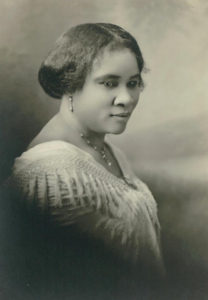Madam C. J. Walker
Born in Delta, Louisiana, in 1867, hair care and cosmetics mogul Madam C. J. Walker was the first African American millionaire.
This entry is 8th Grade level View Full Entry

Madam C.J. Walker Family Archives
Madam C.J. Walker
What was C. J. Walker’s early life like?
Hair care and cosmetics mogul Madam C. J. Walker was one of the first Black female millionaires. She was born in poverty as Sarah Breedlove on December 23, 1867, in the village of Delta, Louisiana, across the Mississippi River from Vicksburg, Mississippi. Breedlove earned her fortune through the successful production and marketing of beauty products for Black women. Her parents, Owen and Minerva Breedlove, had been enslaved on a Madison Parish plantation. Breedlove was the first member of her family born into freedom. Her childhood was fraught with hardship. Both parents had died by the time she was seven years old, so she moved to the home of her older sister Louvenia and her brother-in-law Willie Powell. Powell was abusive. To escape his abuse, Breedlove married Moses McWilliams at age fourteen. She became a widow at age twenty and was forced to move with her daughter Lelia (later known as A’Lelia) to St. Louis, Missouri, where three of Breedlove’s four brothers had settled. Breedlove found work doing laundry for others, and in 1894 she married John Davis. The couple divorced in 1903. She joined the African Methodist Episcopal Church, where she encountered other middle-class African Americans who answered Booker T. Washington’s call to self-improvement and enterprise. Inspired by her own hair loss, she prepared and sold shampoos and ointments containing sulfur to treat scalp disease. Her brothers, who worked as barbers, provided her with an introduction to the hair-care business.
Breedlove moved from St. Louis to Denver, Colorado, in 1905, reportedly to find a market less crowded with hair-care products. There she worked as a cook and took in laundry, saving money to invest in her business and to pay for her daughter’s college tuition. Her rise from poverty to the middle class was marked by her marriage in 1906 to the newspaper advertising salesman Charles Joseph Walker, who gave her the name “C. J. Walker” under which she became famous. She remained Madam C. J. Walker after their divorce in 1912 and called her firm the Madam C. J. Walker Manufacturing Company.
How did Walker develop and grow her business?
The demand for her product line, which addressed the cosmetic concerns of Black women, proved to be enormous. In the early years Walker and her husband traveled door to door, selling products like “Madam Walker’s Wonderful Hair Grower.” Eventually she recruited an army of salespeople who sold her products. Advertising in Black newspapers was a crucial element in reaching consumers; Walker’s daughter operated a booming mail-order business in shampoos and ointments. In 1908 Walker moved to Pittsburgh, where she established a short-lived school that trained Black women to style hair. In 1910 Walker relocated to Indianapolis, where she built a factory and corporate headquarters that employed more than three thousand people. Walker reported that her sales force had more than twenty thousand agents by 1919. She moved in 1917 to the Villa Lewaro, a mansion in Irvington-on-Hudson, New York, designed by the Black architect Vertner Tandy. The estate became an intellectual gathering place for notable leaders of the Harlem Renaissance such as James Weldon Johnson, Zora Neale Hurston, W. E. B. Dubois, and Langston Hughes. Walker died there on May 25, 1919.
How did Walker advocate for the advancement of African Americans?
Although she had little formal education, Walker was a determined woman, never content merely to amass wealth from the sale of shampoo and cosmetics. A social activist devoted to the advancement of African Americans, Walker encouraged Black women to establish businesses and became one of the country’s most popular Black lecturers on social, political, and economic issues. She donated generously to the National Association for the Advancement of Colored People (NAACP) and other Black organizations, especially schools and orphanages. She made the largest single donation to the National Association of Colored Women’s effort to buy the home of Frederick Douglass in Washington, DC, so that it could be preserved as a museum. After Walker’s death, daughter A’Lelia Walker became president of her mother’s company as well as a patron of the Harlem Renaissance.
Reflecting upon her remarkable life story, Madam C. J. Walker said, “I am a woman who came from the cotton fields of the South. From there I was promoted to the washtub. From there I was promoted to the kitchen cook. And from there I promoted myself into the business of manufacturing hair goods and preparations.” Although it was among the most successful Black-owned businesses in America during the early twentieth century, the Madam C. J. Walker Manufacturing Company didn’t keep pace with changing times and increased competition. It ceased operations in 1981. The Walker Theatre Center, a project Walker began in Indianapolis before her death, has been revived in recent years as an important performing arts facility. Walker’s birthplace has been converted into the City Hall of Delta. The National Trust for Historic Preservation declared Villa Lewaro a “national treasure” in 2014, and efforts are underway to preserve the mansion.
